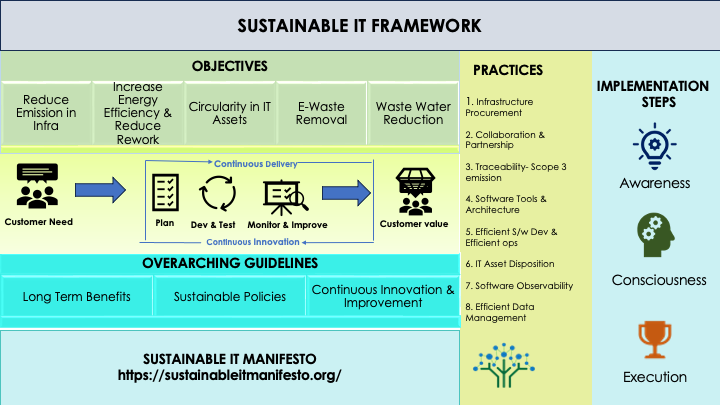The Sustainable IT Framework is created by Green Computing Foundation. The Sustainable IT Framework is a pre-built structure that provides a foundation for practicing Sustainable IT. Its purpose is to streamline and simplify the Sustainable IT Practice by offering a reusable, standardized set of Best Practices, Metrices, Assessments and Conventions. Sustainable IT Framework is designed to address common challenges and tasks in practicing Sustainable IT, making it easier for The primary purpose of Sustainable IT Framework is to integrate Environmental, Social, and Governance considerations into IT decision-making and operations.
Key objectives of Sustainable IT Framework
Environmental Impact Reduction:
Energy Efficiency: Promoting the use of energy-efficient hardware and data centers to minimize energy consumption and reduce the carbon footprint.
Waste Reduction: Implementing strategies to minimize electronic waste through responsible disposal and recycling practices.
Resource Conservation:
Resource Efficiency: Encouraging the efficient use of IT resources such as servers, storage, and network devices to optimize performance and minimize resource consumption.
Materials Sourcing: Considering sustainable sourcing of materials for IT equipment to minimize the environmental impact of production.
Social Responsibility:
Ethical Sourcing: Ensuring that IT products are sourced ethically, with consideration for human rights, fair labour practices, and social responsibility.
Accessibility: Focusing on making IT solutions accessible to a diverse user base, including people with disabilities.
Cost Savings and Efficiency:
Operational Efficiency: Streamlining IT processes and adopting technologies that contribute to overall operational efficiency, resulting in cost savings.
Long-Term Financial Benefits: Investing in sustainable practices that may lead to long-term financial benefits, such as reduced energy costs and lower total cost of ownership.
Compliance and Governance:
Compliance with Regulations: Ensuring compliance with environmental regulations and industry standards related to IT operations.
Governance: Establishing policies and procedures to govern sustainable IT practices and regularly assessing and reporting on performance.
Innovation and Technology Adoption:
Encouraging Innovation: Fostering a culture of innovation to develop and adopt sustainable technologies and practices.
Renewable Energy Adoption: Exploring and adopting renewable energy sources for powering IT infrastructure.
Stakeholder Engagement:
Communication and Transparency: Engaging with stakeholders and communicating the organization's commitment to sustainable IT practices transparently.
Employee Awareness: Educating employees about the importance of sustainable IT and encouraging their active participation in eco-friendly initiatives.

Components Of Sustainable IT Framework
Objectives1. Reduce Emission in Infrastructure 2. Increase Energy Efficiency and Reduce Rework in Software Development 3. Circularity in IT Assets 4. E-Waste Removal 5. Waste Water Reduction Overarching Guidelines1. Long Term Benefits 2. Sustainable Policies 3. Continuous Innovation & Improvement Practices1. Infrastructure Procurement 2. Collaboration and Partnership 3. Traceability of Scope 3 Emission in both Hardware and Software 4. Efficient Software Development and Efficient Operations 5. IT Asset Disposition 6. Software Observability from Sustainability point of view 7. Efficient Data Management |
Implementation Steps1. Awareness through Training Programs 2. Consciousness through Assessment 3. Execution providing Enablement Sustainable IT ManifestoThe 12 points of the manifesto are the guardrails. shaping behavior, managing risks, ensuring compliance, and aligning activities with organizational objectives. They provide a structured yet adaptable approach to guide individuals or teams, fostering a culture of responsible decision-making within the defined parameters. 1. Energy Efficiency Over Raw Performance 2. Resource Efficiency over Resource Abundance 3. Holistic Impact over Siloed Focus 4. Long Term Sustainability over Short Term Gains 5. Return to Environment over Return on Investment 6. Adaptive Planning over Fixed Roadmaps 7. Inclusive Collaboration over Isolated Decision Making 8. Transparent Reporting over Selective Disclosure 9. Continuous Environmental Learning over Static Knowledge 10. Community and Ecosystem Well being over Individual Benefits 11. Eco-friendly Materials over Cheap Alternatives 12. Device Longevity over Planned Obsolescence |
